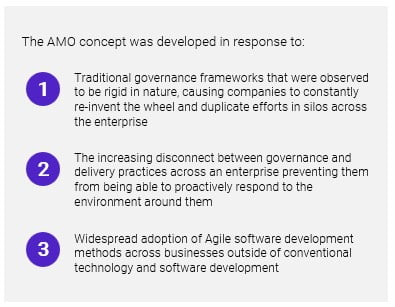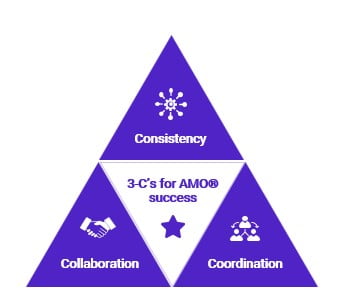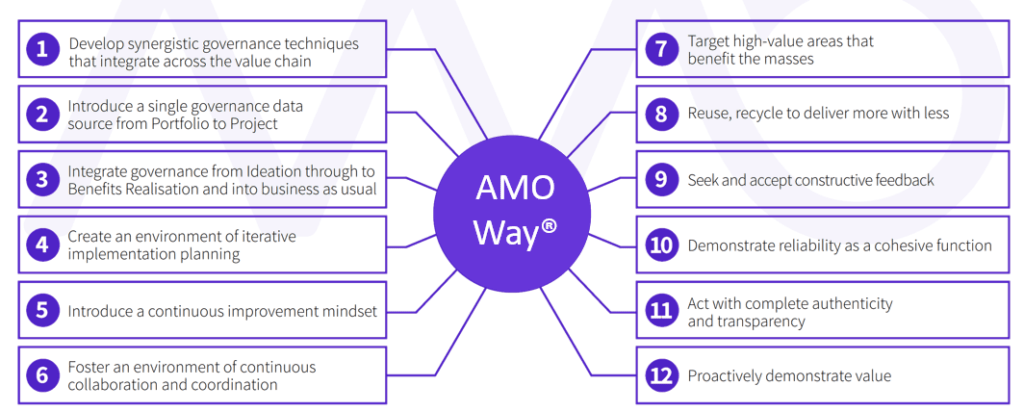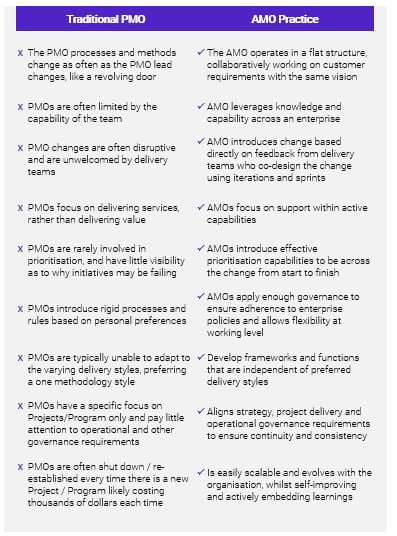Ever since establishing Agile Management Office (AMO) in 2016, the most common question we get asked is “what is the difference between an AMO and a PMO?”. Before answering that question, we usually like to point out what AMO is NOT.
What AMO is NOT
AMO is NOT a Project methodology; there are plenty of those that exist already. The challenge is often PMOs are subjected to, or choose to utilise such methodologies to run their PMOs. Project Methodologies are for Projects and should NOT be used to run PMOs. AMO is NOT another word for PMO. We haven’t simply changed the ‘P’ to an ‘A’ and expecting different results.
AMO was born out of a need to find a more adaptive, flexible, and agile way of working for organisations. A way of working that didn’t completely reinvent itself every time there was a change at the helm. One that is more effective and efficient. But why?
What is the problem that organisations are facing today that led us to the conclusion that something had to change?
The Problem with using traditional methods for Portfolios, Programs, and Projects
Every time we initiate a new Portfolio, Program, or Project we keep reinventing the wheel. This is neither efficient nor effective as our organisation’s governance needs evolve over time.
Traditional Portfolio, Program, and Project methodologies often use a ‘one size fits all’ approach. Often this is inflexible and inefficient at addressing specific governance needs and expectations.
With AMO, you start with the core elements, these core elements underpin everything we do next. They help identify what you need to add or subtract. The core elements form the Minimum Viable Product (MVP), you then add and subtract and evolve from there. We look at what’s needed or not needed and go from there.
Common Pitfalls of a Traditional PMO
The traditional PMO was born around the 1950s and was established as a way to centralise management of business projects. The original PMO model was a command-and-control type model.
“The traditional PMO method have now resulted in more paperwork than collaboration.”
A traditional PMO does NOT look at the bigger picture, focusing only on the here and now. Their time is consumed with often repetitive reporting that doesn’t provide value, or conversing with Project Managers on why they must comply, and therefore lack the time and sometimes vision to look at the bigger picture. In many organisations, satisfying the PMO requirements (or demands) often results in trying to fit a square peg in a round hole.
After reading the above, we expect you to have a few questions. How does an organisation change itself and its PMOs to thrive in what’s becoming a more agile world for the delivery of projects and programs? How do PMOs deliver more with less? How do PMOs maintain processes with flexibility? How do PMOs provide greater transparency and support without the overheads?
Becoming Agile
There is a misconception that adopting agile ways of working means you can rid yourself of PMOs as they are not required. False! Although the actual term PMO does not form part of the ‘Agile’ landscape, the role that a PMO provides is now more crucial than ever.
Governance will always be applicable regardless of its source. It may be external regulations, enterprise policies, or project-specific requirements. A move to Agile means we need to enhance the way we govern. As a partner in delivery, the AMO practice works with teams to ensure alignment across the value chain. Removing roadblocks streamlines repeatable processes and enables teams to move at speed.
“Isn’t it time we change the tired, cumbersome, outdated model that exists today?”
Introducing the Agile Management Office (AMO)
Agile is gaining more and more popularity. It is evident that traditional governance models are inflexible. They are unable to adapt to the changing environment around them. In delivery, there is often a myriad number of methodologies available. It can become a minefield for debates over what forms ‘good’ governance. The ambiguous role of PMO and its often-incomplete implementation limits their effectiveness. This was the theme of our 2019 White Paper ‘Is the PMO still fit for purpose?’.

What makes an AMO different?
This “breakthrough” agile solution challenge traditional models. It evolves itself and provides flexibility and adaptability. As well as ensuring governance requirements are exceeded.
One part of The AMO Way model is our Critical Success Factors:

- Consistency is critical in reducing rework and minimising duplication, and increasing productivity;
- Collaboration is the effort of bringing the right people working together to co-design the future. Whilst looking at ways to improve.
- Coordination is how you manage the complex and bring it all together, utilising the right people at the right time, for the right things.
AMO is developed in consultation with executives and delivery teams using a unique approach. Once established it focuses on ensuring these principles are applied with a considered approach.
Key features of the AMO Way Model – the model we’ve developed to implement an AMO includes:
- Targeting high-value areas, shifting priorities and attention to where it’s needed most
- A model that interacts with all stakeholders
- It enables better ‘governance’ that is transparent to those embracing the change
- It results in capability uplift and continuous improvement
- Supportive of Peaks and Troughs
The AMO Way Guiding Principles

Key differences between the traditional PMO and an AMO Practice
Below is a brief overview of how the two differ. We have seen many practical examples and they have continued to evolve over time. From multi-national businesses to small businesses. An AMO setup right will provide lasting benefits.

Is an AMO for me?
- The AMO practice introduces an effective environment for governance to thrive. One that is supportive, not disruptive. It works with, not against delivery teams. It provides a holistic picture for executives in real-time.
- From techniques and data-source perspective. The AMO framework defines inputs, outputs, and processes for Projects, Programs, and Portfolios. These are synergistic and target high-value areas first whilst scaling with an organisation.
- It ensures alignment from executive strategy through delivery and into operations. It introduces documentation and governance structures selected based on their relevancy and merit. Rather than a need by a single person.
